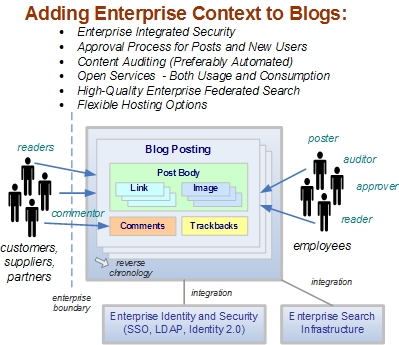Adding enterprise context to blogs

As I wrote about early this week, I'm going to start looking at the context that needs to be added to Web 2.0 software for it to be more appropriate for the enterprise. Of course, that means the premise here is that many of the significant trends on the Web – the continued rampant growth of blogs, the increasingly widespread use of wikis, and even the social networking phenomenons like MySpace and Facebook – are both possible and desirable to replicate in the enterprise.
Too much control kills the goose laying the golden eggs of content, while too little results in an unstructured morass.Why do we believe this? For one thing, consumer Web 2.0 focuses on radical ease-of-use, or it wouldn't achieve the high level of adoption it has in many cases. Blogs and wikis are probably the best example of this; they often don't have more than a Post or Save button and maybe a simple WYSIWIG HTML editor.
In truth, complexity has always been an enemy of user adoption and is something enterprise software doesn't emphasize enough. Enterprise content management (ECM), an enterprise big brother of wikis, is famous for its blizzard of complex features, which helps justifies the price tag but all too often doesn't help the content producer or consumer very much.
Balancing true ease of use with rich capability does appear to be vital for maximizing and sustaining user adoption and even cutting support costs. My experience tells me that enterprise software is often optimized for early adopters or getting through the acquisition evaluation process, and frequently focuses too little on the average user or the most common daily uses.
This is where the software Darwinism of Web 2.0 shines. In that clunky, hard-to-use software is routed around in favor of things that get the job done. The next solution is frequently just a URL away. If anything, this model implies that SaaS is really the more effective model utimately, when managed for this strength. This will particularly come into play when content portability and provider switching becomes more possible, and widespread, even necessary for competitive advantage.
Another key aspect of Web 2.0 is its relative openness and lack of central control; a kind of democratization process, as I've discussed in recently. This gives us automatic syndication of content (with RSS and Atom), the ability for the most users to change content (or at least enrich it with comments, links, discussion), and even the ability to organize and structure content in a way that works for them (tagging, microformatting, etc.) And this is right where Web 2.0 for the enterprise starts running into rocky ground. Enterprises still need a higher level of control than consumer Web 2.0 is inclined to provide.
However, Harvard's McAfee pointed out recently in his Enterprise 2.0 musings (exerpt at the bottom of this post) that it's precisely this excessive control and structure that is the problem. Too much kills the goose laying the golden eggs of content, while too little results in an unstructured morass. Again, the premise is that the various popular Web 2.0 phenomenons are showing us approximately where the balance might lie. So, let's try to find the right enterprise context and balance.
As we do this, we'll be using this diagram of the elements of Web 2.0 to help explore the space, and hopefully even produce a dedicated version of this visualization for Web 2.0 in the Enterprise when we're done.
A Possible Enterprise Context for Blogs
So, to get on with the enterprise context for blogs, here's my take on what is likely to be required, along with the most common use cases. Having worked on enterprise architecture for years, this context tends to lie across the highest priority aspects of enterprise integration, governance, and control, including integrated security, auditing, hosting, inclusion of external data sources, and even federated search:

This brings us to the uses of blogs in the enterprise, which adds a final type of context. The primary use of blogs in the enterprise is the same as on the greater Web of course; the ability to publish relevant syndicated content in a collaborative fashion (with comments, trackbacks, linkbacks.) However, instead of it being a personal diary, the enterprise blog usage usually consists of corporate communication, situation reports, project management, etc. In fact, a fascinating survey from the Gilbane Group (with admittedly, a relatively small sample), tells us a story of how blogs are being used in the enterprise today:
- Marketing and Public Relations (~25%)
- Content Management (~26%)
- Customer Communication (~28%)
- Project Collaboration (~42%)
- Knowledge Management (~44%)
- Internal Information Dissemination (~42%)
- Other (~5%)
The survey also shows that blogging is more widespread in smaller companies, though this could certainly be skewed by the fact that there are many more smaller companies. Thus, the bottom line not to be if and how blogging will be extensive within the enterprise, but how well it will be done.
On the downside front, there are relatively small numbers of cases where blogs or wikis are used inappropriately (some good comments here by Ross Mayfield), but auditing and controls could be added with relative ease, and hopefully in an automated fashion, so that suspect posts are held in queue for review. Not that any of the corporate blogging applications in my software list for Web 2.0 for the enterprise has such a feature, so maybe this isn't important to enterprises and I have some of the context wrong, but you be the judge.
What do you think? What enterprise context are blogs presently lacking?